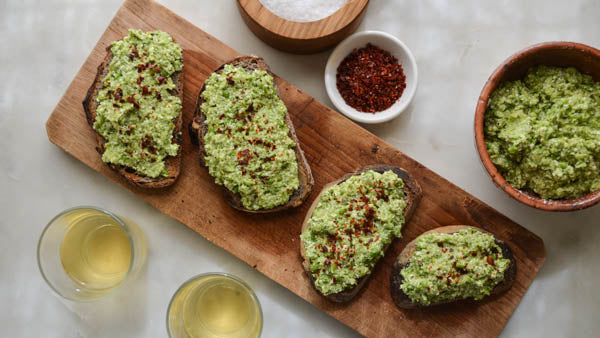Spring Pea and Ricotta Bruschetta with Fines Herbes

This site has limited support for your browser. We recommend switching to Edge, Chrome, Safari, or Firefox.
FREE shipping on orders of $50 or moreFREE shipping will be applied at checkout
Spend $50 more for FREE shipping!FREE shipping will be applied at checkout
Sorry, looks like we don't have enough of this product.


By Christina Cordova
Rated 5.0 stars by 1 users
Appetizer
By Christina Cordova
3-4
It’s officially spring, and whether that means warmer temps or torrential downpours (or both) in your neck of the woods, it also means a preponderance of new seasonal veggies appearing in CSA boxes and farmers market stalls.
Some of these long-awaited ingredients are so synonymous with spring, they lend themselves to seemingly self-evident applications: under a blanket of hollandaise, or folded into a frittata, or rustically tossed in your pasta primavera.
But while radishes, fava beans, English peas, and carrots may be at their peak sweetness and freshness, they’re often relegated to perfunctory sides that don’t do them justice. One of the best rewards of seasonal produce is experiencing that once-in-a-harvest flavor, so how do you bring out the best in your spring veggies without masking their potential?
Enter Fines Herbes. Leave it to the French to come up with a nuanced seasoning that only accentuates the delicate flavors of certain ingredients. Traditionally comprised of parsley, chives, tarragon, and chervil, Fines Herbes (pronounced feen airb) is the blend your spring produce has been waiting for.
This herby melange was born out of the early days of French haute cuisine in the 17th century, when chefs embarked on a more refined approach to cooking. Rather than covering or competing with the inherent flavors of ingredients by using strongly spiced sauces and vinegars (as was the practice before), they began to focus on accentuating and intensifying those natural flavors instead. They turned to more subtle seasonings like herbs, fortified stocks, and butter -- lots and lots of butter. The four ingredient blend we know today was canonized by none other than Escoffier himself in his 1903 book Le Guide Culinaire, and is widely used in French cuisine to this day. Traditionally employed in egg, potato, or fish dishes, as well as sauces, it’s an ideal accompaniment to the produce of spring.
Why it works: Parsley adds its reliable grassy herbiness, chives bring a mellow savory onion flavor, with tarragon and chervil supplying different degrees of bright and sweet anise flavor. Together they bring out the sweetness of spring veggies while adding some earthy depth, but nothing to compete with the delicate flavor of your seasonal bounty.
Parsley and chives are ingredients most of us are well acquainted with, but tarragon and chervil are slightly less familiar to many American cooks. Chervil is a close relative of parsley, with a subtle flavor often described as a cross of tarragon and parsley. So, then, what does tarragon taste like? Tarragon is beloved by many for its citrusy herbaceousness and anise-like flavor, and is particularly popular in French cuisine. In Georgia (not that Georgia) and Russia, it is the base of a popular soft drink called Tarkhun.
For those of us who have not grown up making bearnaise sauce or drinking Tarkhun, using Fines Herbes is a great way to experiment with tarragon for the first time. The other herbs round out the flavor and give you ample wiggle room if you happen to add a dash too much. Cook up those spring veggies with confidence; Fines Herbes has got you covered.
What should you do with Fines Herbes this spring? Use it to flavor your favorite mayonnaise as a delicious dipping sauce for freshly steamed artichokes; fold into Greek yogurt for topping poached salmon; mix into good quality butter and serve with fresh radishes and a crunchy salt; stir into a creamy carrot soup, or use in the recipe below!
2 teaspoons Oaktown Spice Shop Fines Herbes
Aleppo Chile Pepper, for garnish
Cyprus White Sea Salt, for garnish
Scrape into a bowl and let cool for 10 minutes before adding ricotta. Mix gently until fully combined. Taste for seasoning, adding salt and pepper if needed. Toast some thick slices of good bread and spread with plentiful dollops of pea mixture. Sprinkle with chile flakes and crunchy salt. Can be made a day in advance.
Alterations: This recipe could be made vegan by omitting the ricotta, and shelled fava beans could also be used in place of, or in addition to peas.



